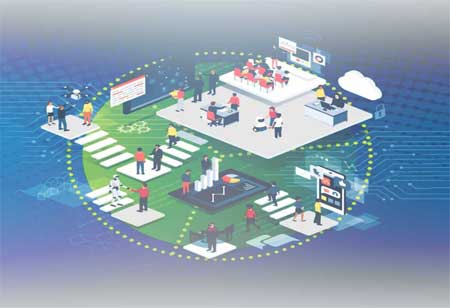THANK YOU FOR SUBSCRIBING
Exploring Automation Trends In Document Management
Automation is gaining popularity and significance across diverse industries.

By
Apac CIOOutlook | Wednesday, September 20, 2023
Stay ahead of the industry with exclusive feature stories on the top companies, expert insights and the latest news delivered straight to your inbox. Subscribe today.
From AI-driven data extraction to mobile accessibility, automation trends in document management are enhancing efficiency, compliance, and sustainability.
FREMONT, CA: Automation is gaining popularity and significance across diverse industries. It stands as a vital trend in the domain of document management, where organisations are proactively pursuing technological solutions to streamline their processes and reduce costs.
Document automation, commonly referred to as document assembly or generation, entails a technology-powered process that optimises document creation, management, and distribution. It has gained substantial momentum in recent years, transforming the way companies handle paperwork and documentation. As businesses strive for efficiency, cost savings and enhanced compliance, document automation has become paramount.
Artificial intelligence (AI) is at the forefront of document automation. AI-driven solutions facilitate data extraction from unorganised documents encompassing invoices, contracts, and emails with considerable accuracy. Machine learning (ML) algorithms empower these systems to enhance their performance over time, reducing manual intervention requirements.
Natural language processing (NLP) is an important advancement, which enables machines to comprehend and interpret human language. NLP serves a pivotal role in document automation by facilitating systems to process and categorise documents intelligently. This proactive approach improves accuracy and opens new avenues for more sophisticated document automation processes such as contract analysis and risk assessment.
The integration of cloud technology has transformed document automation. Cloud-based solutions provide scalability, accessibility, and collaboration features that outpace conventional on-premises software. This allows organisations to store, access, and edit documents from anywhere, enabling remorse work and improving overall productivity and performance. Additionally, cloud-based document automation platforms often come with built-in security measures, guaranteeing that sensitive information is protected. With data breaches becoming increasingly common, this trend is paramount in maintaining data integrity and compliance with data privacy regulations.
Document automation is a collaborative process that seamlessly interfaces with diverse software and systems. Integration with customer relationship management (CRM) software, enterprise resource planning (ERP) systems, and content management platforms improves the effectiveness of document generation and distribution. For instance, leveraging CRM software enables the sales team to generate contracts and proposals from customer records, reducing errors and saving time. This collaboration facilitates data synchronisation across systems, effectively eliminating the requirement for manual data entry and reducing redundancy.
The advent of electronic signatures has revolutionised the way documents are signed and approved. E-signature solutions have received legal acknowledgement in various countries, empowering the execution of contracts, agreements, and forms without depending on physical paperwork. This expedites the signing procedure and improves security and adherence to regulations.
Document automation platforms frequently incorporate e-signature features, allowing users to seamlessly integrate signing into document workflows. Digital workflows optimise the movement of documents through approval procedures, employing automated notifications and reminders to ensure timely actions.
Document templates form a fundamental aspect of document automation. However, modern solutions extend this concept further by providing dynamic document templates that facilitate extensive personalisation. This empowers users to craft templates that adapt to diverse scenarios, autonomously filling fields with relevant information. This personalised approach transcends mere data entry encompassing names and addresses. It includes tailoring content in accordance with customer preferences, language, and even branding elements. This heightened level of customisation enriches the user experience and ensures consistency and professionalism in all communications.
As regulations overseeing data privacy and document handling become more stringent, compliance and governance have become paramount considerations for organisations. Document automation systems play a vital role in guaranteeing that documents are generated, stored, and managed in compliance with legal and industry norms.
Multiple document automation platforms encompass features such as audit trails, access controls, and versioning to monitor document changes and maintain a comprehensive history. These resources assist organisations in upholding transparency, monitoring document modifications, and demonstrating compliance as necessary.
In an era where mobile devices have become omnipresent, document automation has adapted to the dynamic demands of constantly moving users. Mobile accessibility enables users to craft, alter, and retrieve documents through smartphones and tablets, facilitating greater flexibility and productivity. Mobile applications designed for document automation frequently encompass features like offline access, empowering customers to work on documents without an internet connection. This profound shift has proven exceptionally advantageous for field-based professionals requiring access to important documents on-site.
The drive towards sustainability has made its mark in the realm of document automation. Companies are increasingly conscious of their environmental impact and are seeking new possibilities to minimise paper usage. Document automation plays a crucial role in attaining this goal by lowering physical documents and printing requirements. Digital workflows and e-signature lessen the carbon footprint based on conventional paperwork. Furthermore, the move to cloud-based systems reduces the energy consumption and environmental repercussions of on-premises data centres.
The success of document automation solutions hinges considerably on their user-friendliness. Interfaces that are easy to navigate simplify the incorporation and empower employees to effectively utilise these systems. Low-code and no-code platforms are gaining popularity, enabling users to craft document automation workflows with minimal coding knowledge. These platforms facilitate business users to design, test, and deploy document automation processes with less IT intervention. This democratisation of document automation expedites its integration within organisations.
In a dynamic, competitive business landscape, automation is indispensable in handling the ever-increasing volume of digital documents. These platforms empower organisations to expedite processes, enhance accessibility, and lessen costs, ultimately bolstering productivity and performance and driving sustainability.





